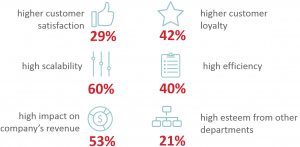Customer service has long fallen into one of two categories when it comes to driving strategic value for an organization. In most cases, it is viewed as a cost center: an important, but tactical investment in post-purchase support.
Organizations with this mindset viewed customer service as an organizational silo focused on balancing between doing “good enough” while continually reducing costs.
For the rarified few, however, customer service is a strategic investment: a key component in the customer journey, a rich source of competitive differentiation and strategic value.
Such organizations view customer service as empowering both customer service representatives as well as customers, thus driving the lifetime value of those customers. Organizations like Nordstrom, Disney, and The Ritz Carlton immediately come to mind.
The common wisdom, however, has always been that this strategic benefit of customer service comes at a high cost – out of the reach of any organization, save for those companies serving luxury, high-margin markets.
To dispel this common, but incorrect conclusion, ServiceNow recently commissioned a survey that indicates that there are three keys to transforming customer service into a source of strategic value – and spending more than your competitors isn’t one of them.
Top and Bottom Performers Spend the Same

Using seven measures of performance, the survey of 200 customer service executives and managers from enterprise and mid-sized organizations segmented the respondents’ companies into three performance tiers.
Top performers predictably realized higher customer loyalty, higher levels of customer satisfaction, greater scalability and greater revenue impact.
Surprisingly, however, the survey found no correlation between spending and performance. Both top and bottom performers spent about the same on their customer service function.
Instead, it found that the drivers of performance were three interrelated organizational characteristics.
The Three Keys to Unlocking Value from Customer Service
The survey found that top performers embraced a set of characteristics that centered on collaboration and communication – both within the organization and among their customers.
Specifically, it found that top performers were:
- 127% more likely to have enabled their customer service agents to enlist the help of different parts of the organization when addressing a customer’s problem
- 163% more likely to be able to address the root cause of a customer’s problem
- 36% more likely to offer self-service for simple requests, thus refocusing customer service staff on more strategic issues.
Moreover, top performers were more likely to embrace omnichannel customer communications, the adoption of industry frameworks (which can help with collaboration and communication), and to use the Net Promoter Score (NPS) to monitor customer satisfaction.
Overall, the unifying message of this survey is that organizations can unleash significant value through a strategic approach to customer service, but only if they root that approach in strategies that enable and streamline collaboration and communication both internal to the organization and with their customers.
Customer Service and Digital Transformation
Digital transformation goes well beyond better mobile apps and web interfaces. In reality, such transformation is customer-driven, end-to-end business transformation.
Maintaining a focus on customer preferences during such transformation requires a rock-solid organizational foundation in order to withstand the pressures that such initiatives mandate. In addition, companies must recognize that true digital transformation requires change at all levels and layers of the organization.
Digital technologies are enabling every organization to change how they serve customers and create new opportunities for competitive advantage – but only for organizations that how to leverage those technologies effectively.
In the past, it did take a lot of money and effort to turn customer service into a strategic differentiator, à la Nordstrom. But as digital technologies and best practices transform every facet of business, advantage is shifting not to those organizations that spend the most, but rather to companies that are able to exploit technology to their advantage as well as to the benefit of their customers.
To achieve this vision of cost-effective digital transformation, companies must embrace technologies that will help them collaborate and communicate rapidly within their organization, create frictionless interactions with their customers, proactively mitigate issues before they arise, and eliminate any underlying issues that will otherwise threaten their relationship with their customers.
The Intellyx Take
Digital transformation, at its core, is about understanding the customer journey and empowering the customer to seize their role within it. Done right, customer service helps an organization engage and empower the customer throughout the customer journey.
As a result, smart organizations are not pushing customer service to the side, but are instead embracing it and placing it in the center of their digital transformation efforts.
Using modern technologies such as workflow automation, self-service portals, omnichannel engagement tools, collaboration and process management tools, automated monitoring and remediation technologies, and the emerging area of the Internet of Things to predict and mitigate service failures, organizations can create sustainable competitive advantage in the marketplace.
Copyright © Intellyx LLC. ServiceNow is an Intellyx client. At the time of writing, none of the other organizations mentioned in this paper are Intellyx clients. Intellyx retains full editorial control over the content of this article.




Comments